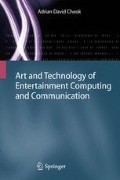Abstract
This chapter details the Human Pacman system to illuminate entertainment computing which ventures to embed the natural physical world seamlessly with a fantasy virtual playground by capitalizing on infrastructure provided by mobile computing, wireless LAN, and ubiquitous computing. With Human Pacman, we have a physical role-playing computer fantasy together with real human-social and mobile-gaming that emphasizes on collaboration and competition between players in a wide outdoor physical area that allows natural wide-area human-physical movements. Pacmen and Ghosts are now real human players in the real world experiencing mixed computer graphics fantasy–reality provided by using the wearable computers on them. Virtual cookies and actual tangible physical objects are incorporated into the game play to provide novel experiences of seamless transitions between the real and virtual worlds. This is an example of a new form of gaming that anchors on physicality, mobility, social interaction, and ubiquitous computing.
Access this chapter
Tax calculation will be finalised at checkout
Purchases are for personal use only
Preview
Unable to display preview. Download preview PDF.
References
Bellotti, V., Back, M., Edwards, W.K., Grinter, R.E., Henderson, A., Lopes, C.: Making sense of sensing systems: five questions for designers and researchers. In: Proceedings of the SIGCHI Conference on Human Factors in Computing Systems: Changing Our World, Changing Ourselves, Minneapolis, MN, USA, pp. 415–422. ACM, New York (2002). http://doi.acm.org/10.1145/503376.503450
Billinghurst, M., Kato, H., Poupyrev, I.: Magicbook: transitioning between reality and virtuality. In: Proceedings of ACM CHI 2001 Conference on Human Factors in Computing Systems. Demonstrations: Technology Play, vol. 2, pp. 25–26. http://doi.acm.org/10.1145/634067.634087
Björk, S., Falk, J., Hansson, R., Nakao, K., Ljungstrand, P.: Pirates! – using the physical world as a game board. In: Interact 2001, IFIP TC. 13 Conference on Human–Computer Interaction, Tokyo, Japan, 2001
Björk, S., Holopainen, J., Ljungstrand, P., Mandryk, R.: Special issue on ubiquitous games. Pers. Ubiquitous Comput. 6(5–6), 358–361 (2002)
Bowlby, J.: Attachment and Loss, vol. I: Attachment. Basic Books, New York (1983)
Cheok, A.D., Yang, X., Zhou, Z., Billinghurst, M., Kato, H.: Touch-space: mixed reality game space based on ubiquitous, tangible, and social computing. Pers. Ubiquitous Comput. 6(5–6), 430–442 (2002)
CIT-online: Communications update. http://www.cit-online.com/info/29082002.htm (2002)
Cohen, J.: Special Issue on Computer Augmented Environments: Back to the Real World. Commun. ACM 36(7) (1993). http://portal.acm.org/citation.cfm?id=159544
Crawford, C.: Live: what a concept! ... networked games. In: Digital Illusion: Entertaining the Future with High Technology. ACM Press Siggraph Series, pp. 241–248. ACM/Addison–Wesley, New York (1998). http://portal.acm.org/citation.cfm?id=274468
Duchamp, D., Feiner, S.K., Maguire, G.Q.: Software technology for wireless mobile computing. IEEE Netw. Mag. 5(6), 12–18 (1991). doi:10.1109/65.103804
Entertainment Software Association: Essential facts about the computer and video game industry. http://www.theesa.com/pressroom.html (2002)
Fitzmaurice, G., et al.: Bricks: laying the foundations for graspable user interfaces. In: Proceedings of the Conference on Human Factors in Computing Systems (CHI’95), pp. 442–449. ACM, Denver (2001)
Forman, G.H., Zahorjan, J.: The challenges of mobile computing. IEEE Comput. 27(4), 38–47 (1994)
Gear, R., Mokka, R., Nelson, R.: Wireless gaming – playing to win. An ovum report (2001)
Ishii, H., Ullmer, B.: Tangible bits: towards seamless interfaces between people, bits, and atoms. In: Proceedings of the Conference on Human Factors in Computing Systems (CHI’97), pp. 22–27
Konami Corporation: Paraparaparadise. http://en.wikipedia.org/wiki/ParaParaParadise (2001)
Long, S., et al.: Rapid prototyping of mobile context-aware applications: the cyberguide case study. In: 2nd ACM International Conference on Mobile Computing and Networking (MobiCom’96), pp. 10–12
Mandryk, R.L., Inkpen, K.M.: Supporting free play in ubiquitous computer games. In: Workshop on Designing Ubiquitous Computer Games, UbiComp 2001, Atlanta, 2001
Milgram, P., Takemura, H., Utsumi, A., Kishino, F.: Augmented reality: a class of displays on the reality–virtuality continuum. In: Proceedings of Telemanipulator and Telepresence Technologies, 1994, pp. 282–292
Myers, D.: Computer game semiotics. Play Culture 4, 334–345 (1991)
Nezlek, J.B., Richardson, D.S., Green, L.R., Schatten-Jones, E.C.: Psychological well-being and day-to-day social interaction among older adults. Pers. Relationsh. 9(1), 57–71 (2002). doi:10.1111/1475-6811.00004
Norman, D.A.: The Design of Everyday Things. Doubleday, New York (1990)
Oshima, T., Satoh, K., Yamamoto, H., Tamura, H.: Ar2 hockey system: a collaboration mixed reality system. Trans. VRSJ 3(2), 55–60 (1998)
Pacmanhattan. http://pacmanhattan.com/
Pascoe, J., Ryan, N.S., Morse, D.R.: Issues in developing context-aware computing. In: Proceedings of the International Symposium on Handheld and Ubiquitous Computing, pp. 208–221. Springer, Karlsruhe (1999)
Pascoe, J., Ryan, N.S., Morse, D.R.: Human computer giraffe interaction – hci in the field. In: Workshop on Human Computer Interaction with Mobile Devices. http://www.dcs.gla.ac.uk/~johnson/papers/mobile/HCIMD1.html
Quantum Research Group Ltd. http://www.qprox.com (2002)
Ryan, N., Pascoe, J., Morse, D.: Enhanced reality fieldwork: the context-aware archaeological assistant. http://www.cs.ukc.ac.uk/pubs/1998/616/content.html (2002)
Schilit, B.N., Theimer, M.M., Welch, B.B.: Customizing mobile applications. In: Proceedings of USENIX Mobile&Location-Independent Computing Symposium, pp. 129–138. USENIX Association, Cambridge (1993)
Schmidt, C., Mines, C., Bedarida, D.E.: Making mobile gaming pay. Techstrategy report (2002)
Smith, C.G.: The hand that rocks the cradle. I.D., 60–65 (1995)
Tamura, H., Yamamoto, H., Katayama, A.: Mixed reality: future dreams seen at the border between real and virtual worlds. Comput. Graph. Appl. 21(6), 64–70 (2001)
Thomas, B., Close, B., Donoghue, J., Squires, J., Bondi, P.D., Piekarski, W.: First person indoor/outdoor augmented reality application: Arquake. Pers. Ubiquitous Comput. 6(1), 75–86 (2002)
Want, R., Hopper, A., Falco, V., Gibbons, J.: The active badge location system. ACM Trans. Inf. Syst. 10(1), 91–102 (1992)
Weiser, M.: The computer for the 21st century. Sci. Am. 265(3), 94–100 (1991)
Weiser, M.: Some computer science issues in ubiquitous computing. Commun. ACM 36(7), 75–84 (1993). http://portal.acm.org/citation.cfm?id=159617
Yang, J., Yang, W., Denecke, M., Waibel, A.: Smart sight: a tourist assistant system. In: ISWC, 1999, pp. 73–78. http://computer.org/proceedings/iswc/0428/04280073abs.htm
Zhang, Z., Shan, Y.: State of the industry report. Report 2000–2001, Entertainment Software Association (2001). http://www.theesa.com/pressroom.html
Author information
Authors and Affiliations
Corresponding author
Rights and permissions
Copyright information
© 2010 Springer-Verlag London Limited
About this chapter
Cite this chapter
Cheok, A.D. (2010). Human Pacman: A Mobile Augmented Reality Entertainment System Based on Physical, Social, and Ubiquitous Computing. In: Art and Technology of Entertainment Computing and Communication. Springer, London. https://doi.org/10.1007/978-1-84996-137-0_2
Download citation
DOI: https://doi.org/10.1007/978-1-84996-137-0_2
Publisher Name: Springer, London
Print ISBN: 978-1-84996-136-3
Online ISBN: 978-1-84996-137-0
eBook Packages: Computer ScienceComputer Science (R0)

